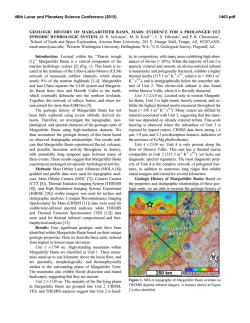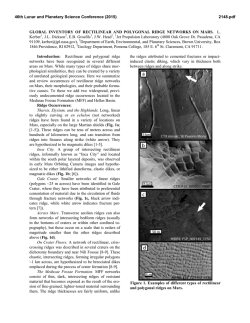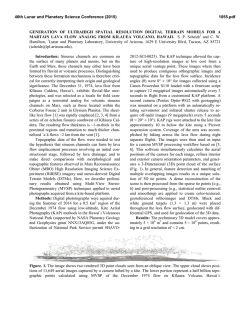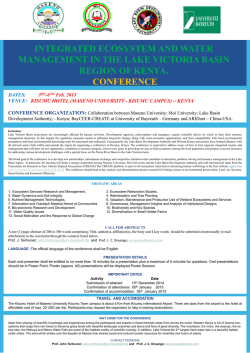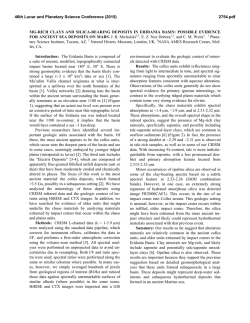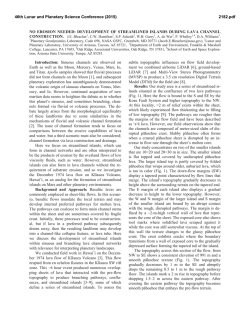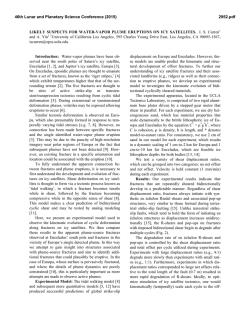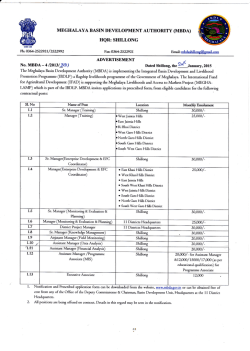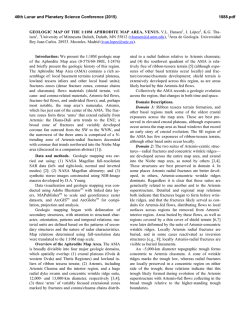
PONDING, DRAINING AND TILTING OF THE CERBERUS PLAINS
46th Lunar and Planetary Science Conference (2015) 1961.pdf PONDING, DRAINING AND TILTING OF THE CERBERUS PLAINS: A CRYOLACUSTRINE ORIGIN FOR THE SINUOUS RIDGE AND CHANNEL NETWORKS IN RAHWAY VALLIS, MARS. J. D. Ramsdale1, M. R. Balme1, 2, S. J. Conway1, C. Gallagher. 1Dept. Physical Sciences, Open University, Walton Hall, Milton Keynes, MK7 6AA ([email protected]). 2Planetary Science Institute, Suite 106, 1700 East Fort Lowell, Tuscon, AZ, USA. Introduction: Rahway Vallis (Fig. 1) is a valley system in the Cerberus Plains of Mars containing a branching network of channels converging on a basin floor. Rahway Vallis is shallow (around 15 metres vertically compared to channel widths of several kilometres) and has convex to rectilinear cross-profiles that are consistent in form across the whole Rahway basin. In this study, we aim to discriminate between possible fluvial, glaciofluvial and volcanic hypotheses for the formation of the landforms in the Rahway basin. tive relief. Lastly, the transition between the older heavily cratered highland terrain and the floor of the Rahway basin is bounded by near-horizontal continuous topographic terraces, with step-like morphology. Analysis: The terraces occur at a consistent elevation: between 3100 and 2850 m below Mars datum. Moreover, when a plane is fitted to these terraceelevations, they conform closely (+/- ~50m) to a consistent, shallow, east-dipping linear trend. This suggests that these terraces represent the high-stand margins of a once-liquid, basin-filling material that formed an equipotential surface. This result is consistent with these features being the result of an infilling of the topography by a fluid that was then removed by drainage. Fig. 1 Map of Rahway, black outline marks edges of the Rahway basin, blue lines mark the channel system. (Inset marks location on global MOLA DEM). Methods: Geomorphological analysis and mapping were performed primarily using publically available Context Imager (CTX ~6 m/pixel; [1]) and High Resolution Stereo Camera (HRSC; 12 m/pixel; [2]) images. MOLA (Mars Orbiter Laser Altimeter; [3]) gridded and point data, THermal EMission Imaging System (THEMIS; [4]), HRSC and High Resolution Science Imaging Experiment images (HiRISE; [5]) were used for additional detail and context. Observations: Both channels and valley descend and deepen consistently from west to east. The channels widen down-slope and increase in width at confluences. The morphology and topology of this channel system are consistent with formation by contributory fluid flow, generated from a continuous source or many distributed sources. In addition to the valley and channel network, we have identified a series of sinuous ridges in the Rahway basin (Fig. 2). The branching pattern of this ridge network is reminiscent of fluvial systems, although the branching landforms are in posi- Fig. 2 (a) sketch map of locations of ridges in central Rahway, grey lines represent Rahway channels and black lines represent sinuous ridges; locations of parts (b-d) of HiRISE image PSP_003623_1900 are indicated by black boxes. (b)Shows intersection of ridges with Rahway channel (c) Shows ridge turning to parallel to Rahway, (d) Shows examples of ridges in troughs. Discussion: Figure 3 illustrates that the Rahway Vallis system as a whole appears to be consistent in form and morphometry with a fluvial origin, although immature as a system compared to a terrestrial river network. The sinuous ridges resemble eskers, possible even eskers set within subglacial canals or tunnel channels. However, there is no other evidence of wet/warmbased glaciation in the region. Consequently, if eskers at all, the sinuous ridges are supraglacial eskers, a type that can form on the surface of dry/cold based glaciers, or they are ridges formed in a cryolacustrine environment by thaw-water draining off the surface, or from 46th Lunar and Planetary Science Conference (2015) within a non-glacial ice-body that filled the Rahway basin. Both scenarios have analogues in the Antarctic [7, 8]. The current gently tilting trend of the terraces implies either that (a) a material filled the Rahway basin and was of low viscosity and continuously flowed in an approximately easterly direction, or (b) the Cerberus plains have been tectonically tilted post-formation, and that the terraces were once at the margins of an equipotential surface. A hypothesis of lake drainage, occurring perhaps as a consequence of an ice or debris-dam failure within (or during the formation of) Marte Vallis, as suggested by Burr et al [6, 9], is most consistent with the evidence, but does not offer a clear explanation for the ridge systems. However, any lake forming on Mars would freeze at its surface, and perhaps at its base, so if the lake was not immediately drained after formation it could have frozen to many metres deep, perhaps even to its base [10]. It is possible that the sinuous ridges formed by sedimentation associated with draining of thaw fluids from the top of a frozen lake, or by draining of unmelted portions of the frozen body. It is unlikely that the ridges could have formed from pressure-melting at the base of an entirely frozen ice-body of such a shallow depth, so they cannot be eskers in the strict glacial sense. Following this hypothesis, glaciofluvial-lacustrine activity was followed by tilting, leading to the trend in elevation seen today. A mechanically similar hypothesis of very fluid lavas infilling, partially solidifying, and then draining, might also be possible (Fig. 3c). However, this mechanism is difficult to reconcile with the fact that such lavas would have had to have remained liquid while travelling extensive distances from source across very shallow slopes, carving a series of channels, forming a single, ponded body with a volume of 1500 km3, and then draining. Conclusions: Rahway Vallis has a ~500 km long, branching channel network with a distributed source. Terrace-like forms bounding Rahway’s basin could be since-tilted, high-stand deposits. Branching sinuous ridges beside the Rahway channels are esker-like in form and size. No other evidence for glacial origin is found within the Rahway region. Our favoured interpretation is for a rapidly filled and then drained lake, which was probably deeply frozen in places. A volcanic hypothesis remains possible, if a model that maintains lava fluidity is found, but does not explain as many observations as a fluvial one. References: [1] Malin, M. C. et al. (2007) JGR 112. [2] Neukum, G. & Jaumann, R. (2004) Mars Express: the Scientific Payload 1240, 17–35. [3] Smith, D. E. et al.. (1993) JGR 1943, 14–18. [4] Christensen, P. R. et al. (2004) Space Sci. Rev. 110, 85–130. [5] McEwen, A. S. et al. (2007) JGR 112. [6] Burr, D. M., 1961.pdf et al. (2002) JGR Lett. 29,. [7] Fitzsimons, S. (1991) Geomorphology 4, 293–299. [8] Hambrey, M. J. & Fitzsimons, S. (2010) Sedimentology 57,. [9]. Burr, D. M., et al.. (2002) Icarus 159, 53–73. [10] Carr, M. H.. (1983) Icarus 56, 476–495. Fig. 3 (a) The landforms currently present in the Rahway basin. (b) A cryolacustrine scenario. (c) A volcanic scenario. The following features are indicated by the roman numerals: (i) basin-marginal ridges, (ii) outliers with terraces and ridges on their margins, (iii) sinuous ridges on channel margins, (iv) basinmarginal terraces, (v) remnant ‘plates’, (vi) infilling material within channels, with grooves in the infilling material showing further channel development, (vii) infilling of Marte Vallis and backfilling into Rahway Vallis; whether Marte Vallis was carved prior to the formation of the channels, ridges and terraces within the Rahway basin is unclear, (viii) although it lies outside the spatial extent of this project, reconnaissance observations show that there are similar-terrace like features south of Marte Vallis, (ix) Crevasses with sediment fill on margins of cryolake, (x) sediment deposition in sub-, en- , and/or supra-ice channels, (xi) terraces form on the margins through deposition of sediment on the margins as the cryolake thaws and drains and/or through ice shielding the lower topography from aeolian erosion, (xii) remnant lava plates on the surface that likely formed contemporaneously with the lavas of the Cerberus Plains that the Rahway channels and valleys are carved into, (xiii) drainage from the Rahway basin onto Amazonis Planita through the proto-Marte Vallis, (xiv) push up ridges formed between lava plates, remnant plates, (xv) lava plates formed on the surface of ponded lavas and deposited on the surface as the lava is then drained, (xvi) terraces form on the margins of the lava lake due to erosion, deflation and/or grounding of lava plates that were attached to the basin margins.
© Copyright 2026
